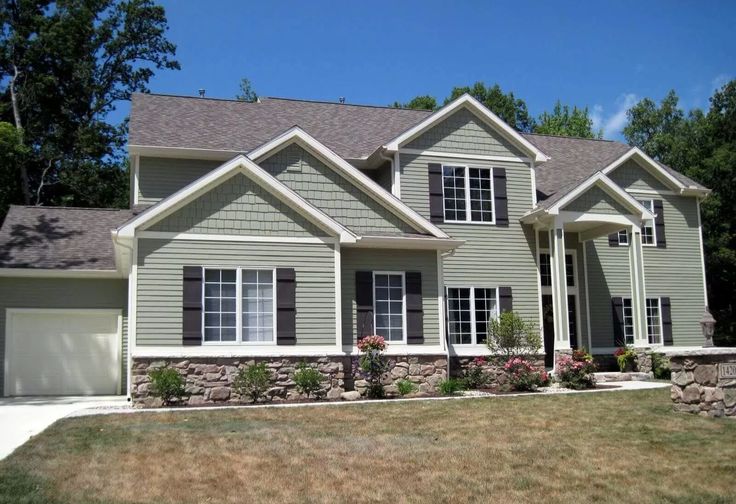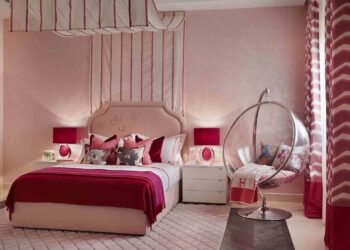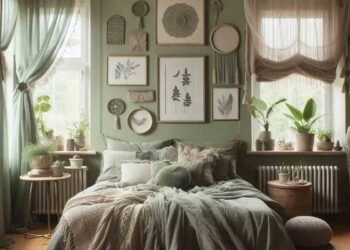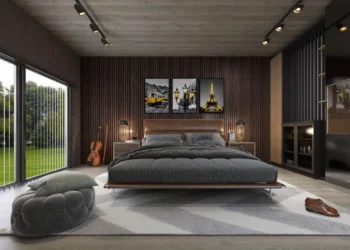Sage green house has a magical quality, they’re timeless and fresh. That soft, muted green-gray tone works with any house style like a modern, a cozy farmhouse, or a classic colonial.
It has a flexible quality that goes with almost every architectural style. Sage green has a way of looking put-together without attention, and it settles into natural surroundings like it was meant to be there.
When you pick the right shade of sage for your home’s exterior, magic happens. All the architectural details like the trim work, the window frames, the porch columns pops. This is the reason why homeowners and designers choose this shade.
Also, sage green houses hold a great resale value. Buyers LOVE this color because it’s pretty without being polarizing. It’s the kind of visual appeal that makes the exterior versatile and relaxing whenever you look at it.
I’m going to take you through 23 amazing sage green house ideas. We’ll look at everything from trim colors to perfect pairings. Whether you’re building a new one, planning a major renovation, there’s something for you here.
Is sage green a good color for an exterior house?
Sage green is one of the best exterior colors you can choose. It’s soft and calming but has character to make your house stand out. The beauty of sage is that it’s not bold or boring and it has a perfect spot of being interesting.
It blends beautifully with landscaping and natural surroundings and makes your house look like it belongs where it is. It works in sunny spots, wooded areas, and beachy locations. Plus, it pairs well with many materials like wood, stone, brick.
White trim makes it look fresh and clean, while black trim gives it a modern edge. Brown roofing is perfect and you can also consider gray roofing too to create a contrast.
One thing I love about sage green is how it changes throughout the day. In the morning light, it has gray undertones and in the afternoon, the green tones come alive and in the evening it creates magic.
23 Best Ideas of Sage Green House: A Serene Exterior
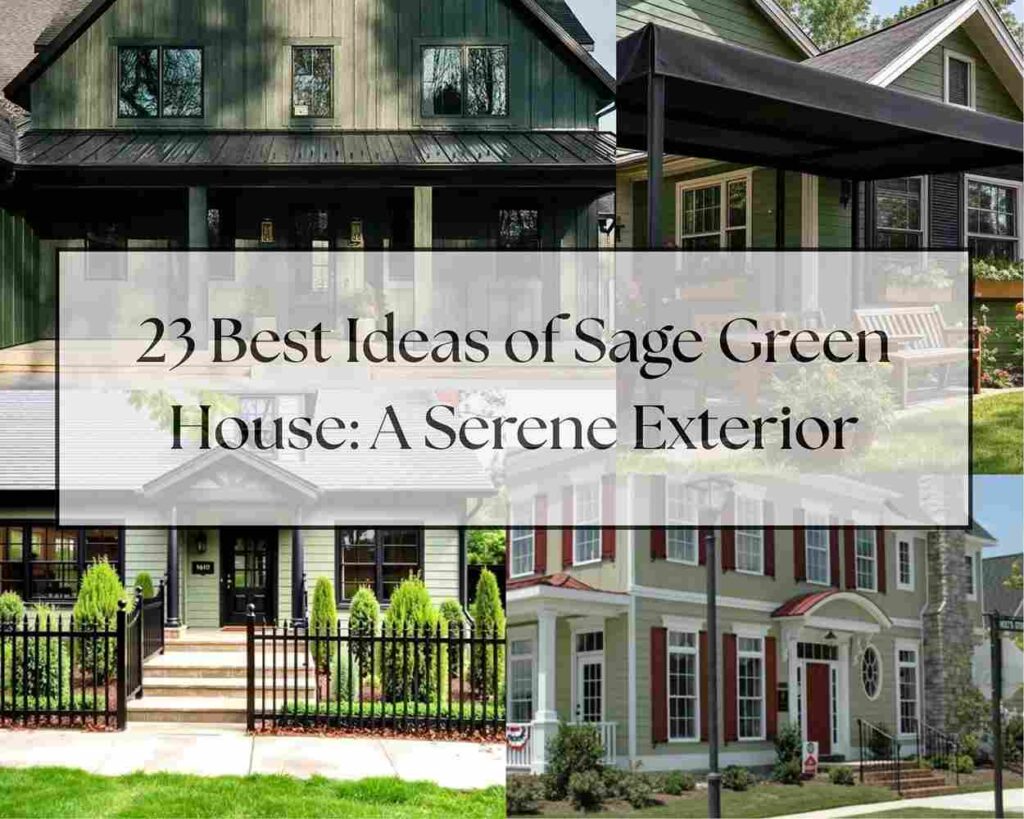
When we talk about a sage green house, it has a versatility which can transform any home exterior from blah to breathtaking. The following 23 ideas show how different elements from trim colors to accents to landscaping can complement and enhance the exterior. These ideas work across architectural styles, from farmhouses to modern homes to traditional colonials.
If you’re ready to be inspired then let’s jump into these sage green house ideas.
Sage green house with black trim
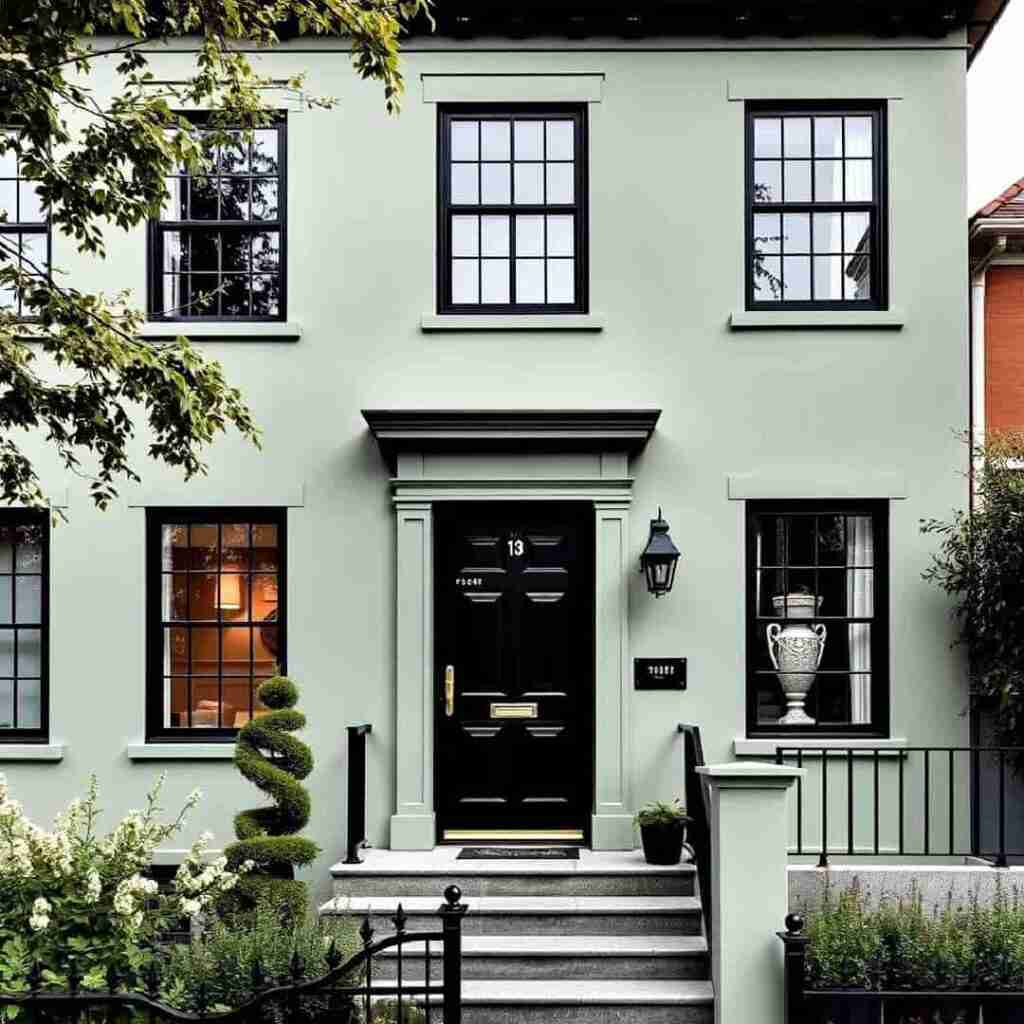
Sage green with black trim creates an amazing high-contrast look that’s both modern and timeless. The soft, muted sage provides a perfect backdrop for bold black trim to shine. This pairing works well on farmhouse styles, craftsman homes, and modern exteriors. The black outlines windows, doors, and architectural details.
For this look to work, choose a sage with gray undertones rather than a yellowish green. Paint all trim elements black like window frames, door frames, fascia boards, shutters, and gutters. Consider Benjamin Moore’s “Saybrook Sage” for the walls paired with a black for trim.
I think this combo looks stunning when you keep the rest of the exterior simple. Add natural elements like a wooden door or copper lighting fixtures.
Pair red brick with sage green exterior
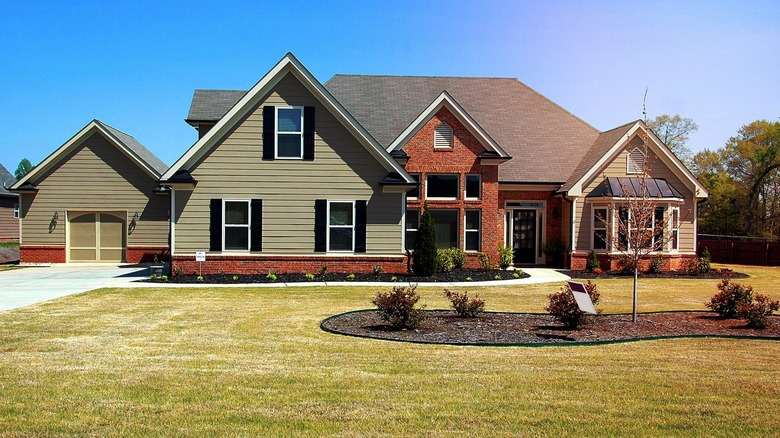
Red brick and sage green are like a perfect combination that brings out the best in each other. The warmth of the red brick balances the coolness of sage green, creating a rich, dimensional look. I love this pairing because it feels established and elegant without being stuffy.
To nail this look, you don’t need to have a full brick house. Consider using brick as an accent like on the lower portion of the house, around the foundation, or as a chimney feature.
What I find about this combo is how it bridges traditional and modern styles. It’s perfect if you want your home to feel established but not old-fashioned. Add black or dark bronze hardware and lighting fixtures. And for the landscaping go with plants that have deep green foliage to create depth against the sage siding.
Add red shutters on sage green house
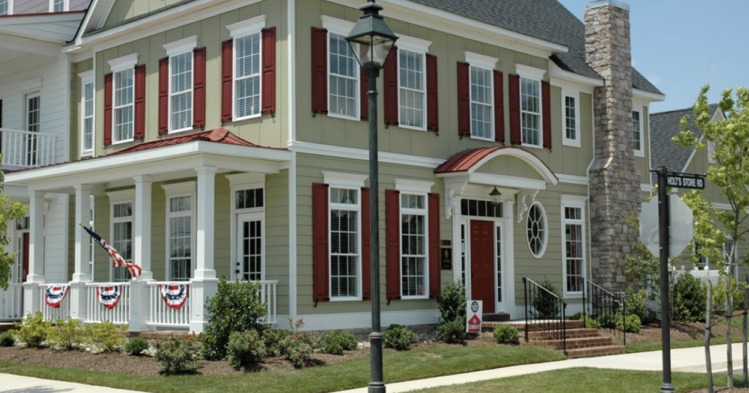
Red shutters against sage green siding is a classic combo without going overboard. The pop of red creates a focal point across your home’s exterior. This pairing works beautifully on colonial, Cape Cod, and farmhouse styles.
When picking red, go for depth like barn red or cranberry rather than fire-engine red. The sage should be light to create contrast with the shutters. Make sure your shutters are properly sized for your windows. They should look like they could close over the windows.
I’m a fan of adding black hardware to this combo, it adds the right amount of grounding. Like black hinges and shutter dogs. This three-color palette, sage, red, and black creates a timeless look.
Wood front door on sage green house
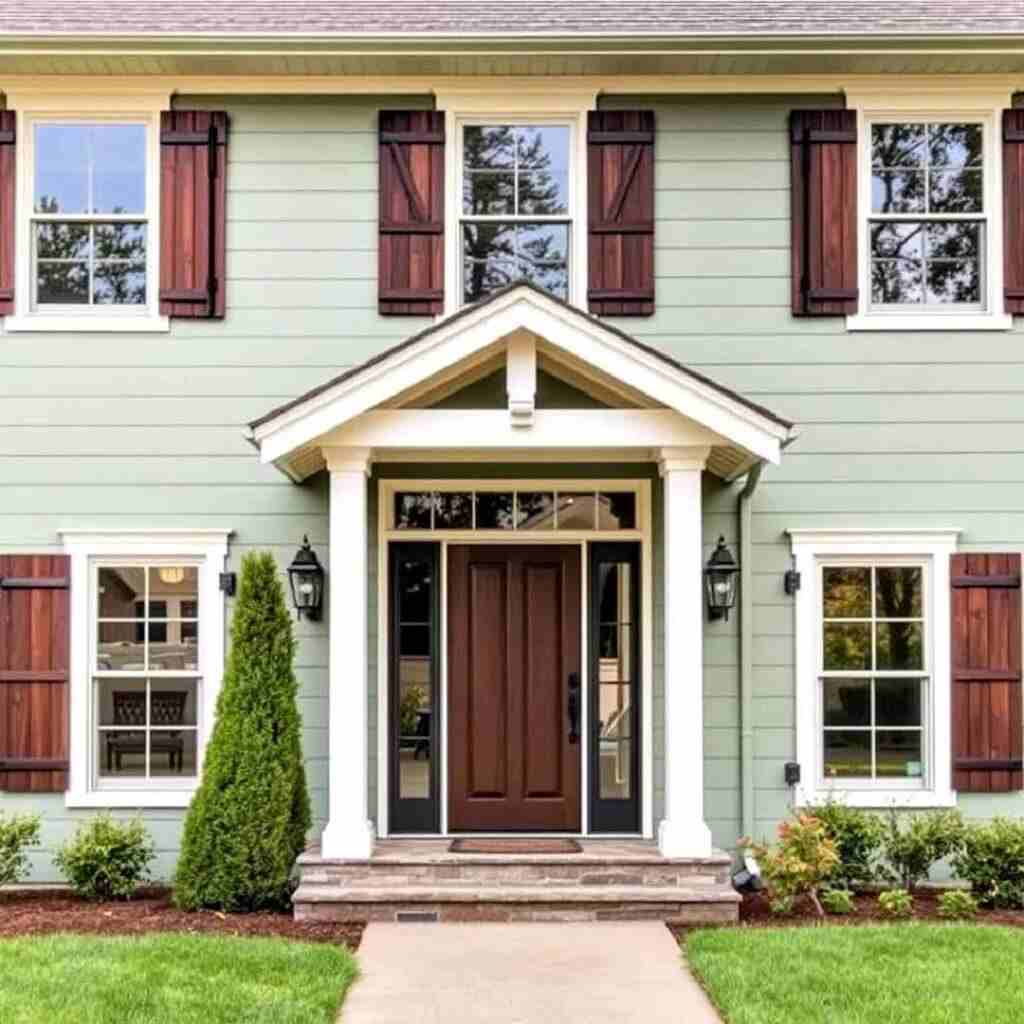
There’s something welcoming about a wood front door on a sage green house. The natural warmth of wood, whether it’s oak, mahogany, or pine creates a contrast against the cool, soft sage. This combination works on any house style, from modern to traditional.
For the stunning effect, choose a door with character like with panels, glass inserts, or interesting hardware. Stain it in a medium to dark tone to create contrast with the sage. Clear coats let the natural wood grain shine, which adds beautiful texture.
What I love about this pairing is how it connects your home to nature. If you want to take this look, consider adding wood elements to your porch too like wooden porch columns or a wooden porch swing.
Sage green house with brown shingles
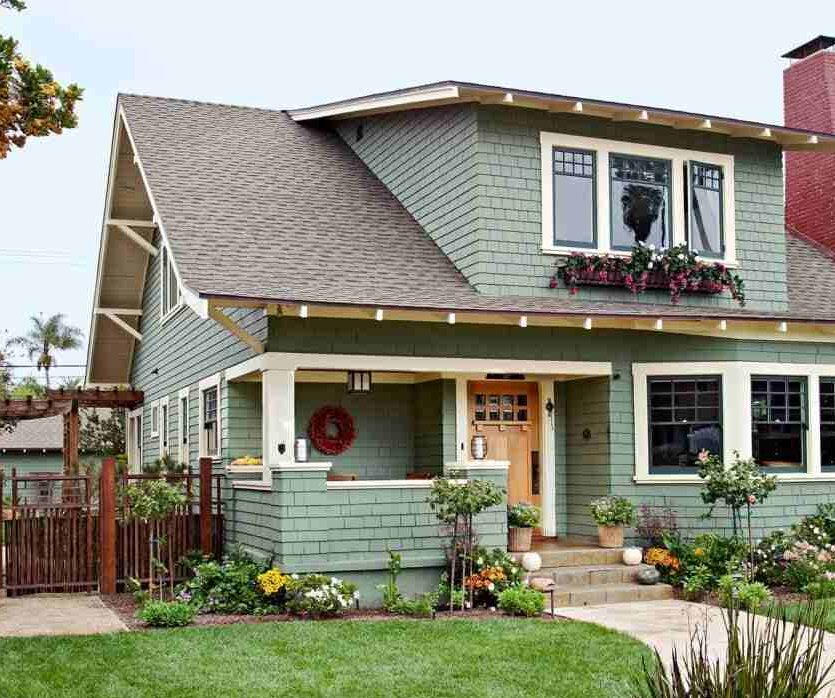
Sage green siding paired with brown shingles creates an earthy, grounded look that feels connected to nature. The brown roof anchors the soft green walls, creating a balanced exterior that’s calming and interesting. This combo gives cottage-in-the-woods vibes, though it works as beautifully on suburban homes and modern farmhouses.
To get this right, choose a medium-toned brown shingle, not too dark and not too light. For the sage, you want a shade with depth to stand up to the brown roof like Farrow & Ball’s “Treron” would be perfect.
I think what makes this combination successful is how natural it feels. For a special touch, add copper gutters and downspouts, they start bright but age to a patina that complements both the sage walls and brown roof. This is definitely one of those timeless combinations that never goes out of style.
Black patio roof on sage green house
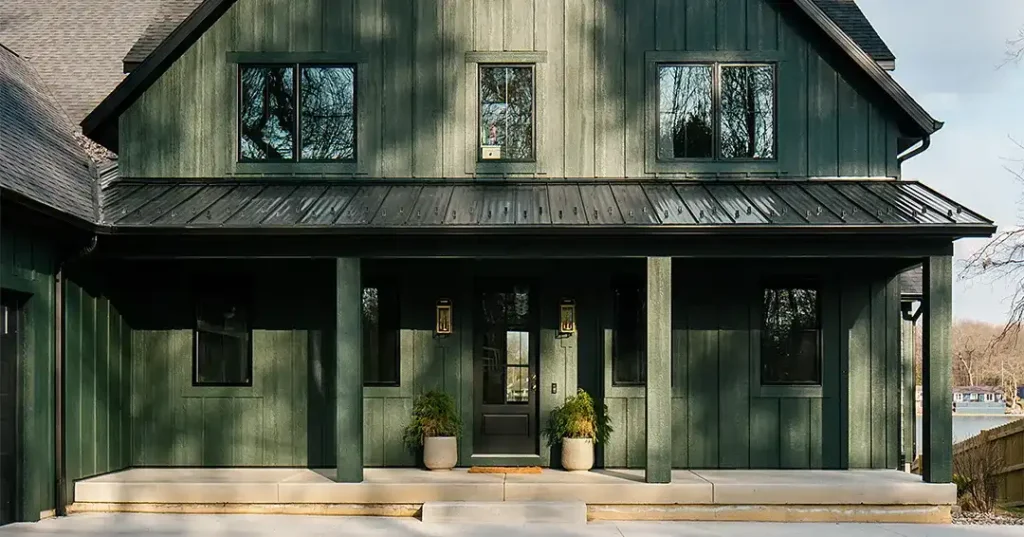
A black patio roof against sage green siding creates a striking, sophisticated contrast! This combo modernizes any home exterior while keeping things warm and inviting. The black overhead structure frames outdoor living spaces beautifully. It’s bold but not overwhelming, with the soft sage as its backdrop.
For this look to work, the black needs to be a rich black, no charcoal. Whether it’s a pergola, covered porch, or patio awning, make sure it’s substantial to create impact. Consider carrying the black to other exterior elements like window frames, doors, or light fixtures for a cohesive look.
I adore how this combination creates a defined outdoor room. To maximize this look, add contrasting furniture underneath like natural wood or white outdoor seating.
Combination of dark and light green house
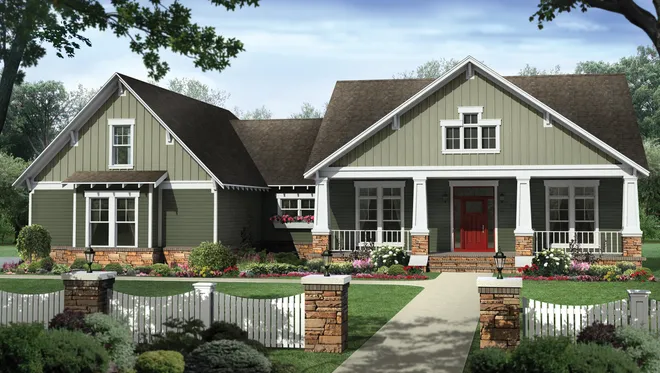
Playing with different shades of green on your house exterior creates a dimensional effect. Pairing a dark green with a light sage green gives your home depth and character without being flashy. This tone-on-tone approach feels sophisticated and intentional.
To execute this look, use the dark green on architectural details like the lower half of the house, the trim, or the front door. Keep the light sage as your main color. The key is making sure there’s contrast between the two greens, but not that much that they look like different colors.
What I love about this approach is how it highlights a home’s architecture without being obvious. This combination works well on houses with architectural details, the color variation helps details pop.
Ranch-style dark green house
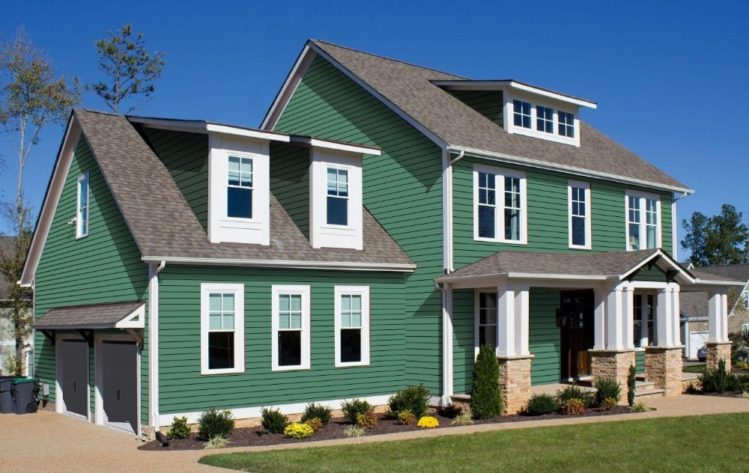
Ranch-style homes and dark green are a match made in heaven. The long, horizontal lines of a ranch house get highlighted by a rich, deep sage green. This combination feels grounded and substantial, giving plain homes a style upgrade.
For this look, choose a deep sage with gray in it, like Farrow & Ball’s “Treron.” Keep the trim simple, either white for contrast or the same dark green for a monochromatic effect that feels current. Black windows add modern touch, while wood accents warm things up.
I think what makes this combo successful is how it turns the simplicity of a ranch into a strength. The clean lines and minimal fuss of the architecture let that deep sage be the star.
Stone pathway against sage green house
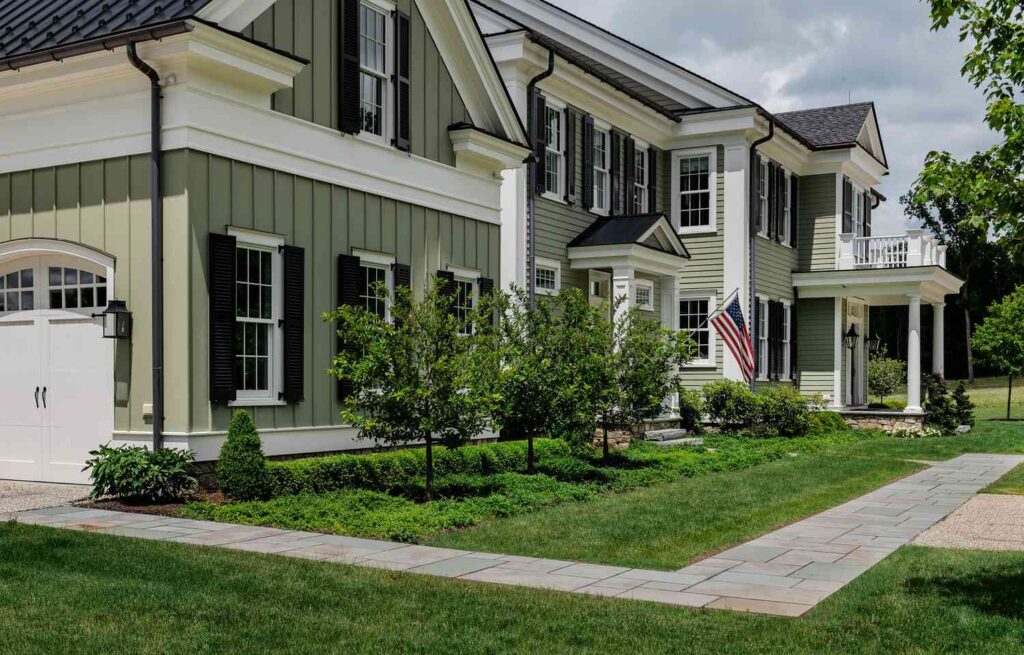
There’s something about a stone pathway leading up to a sage green house. The natural texture of the stones against the soft, muted green creates a harmony that feels straight out of a fairytale.
For this look to shine, choose stones in mixed neutral tones like grays, tans, and browns work beautifully. Let the path curve if space allows because straight lines can feel formal with the natural sage.
I love how this combination looks. To take this look to the next level, add uplighting along the path that illuminates both the stones and the sage green walls. This pairing works with any architectural style but feels magical with cottages, craftsman homes, and modern farmhouses.
Black fencing around green house
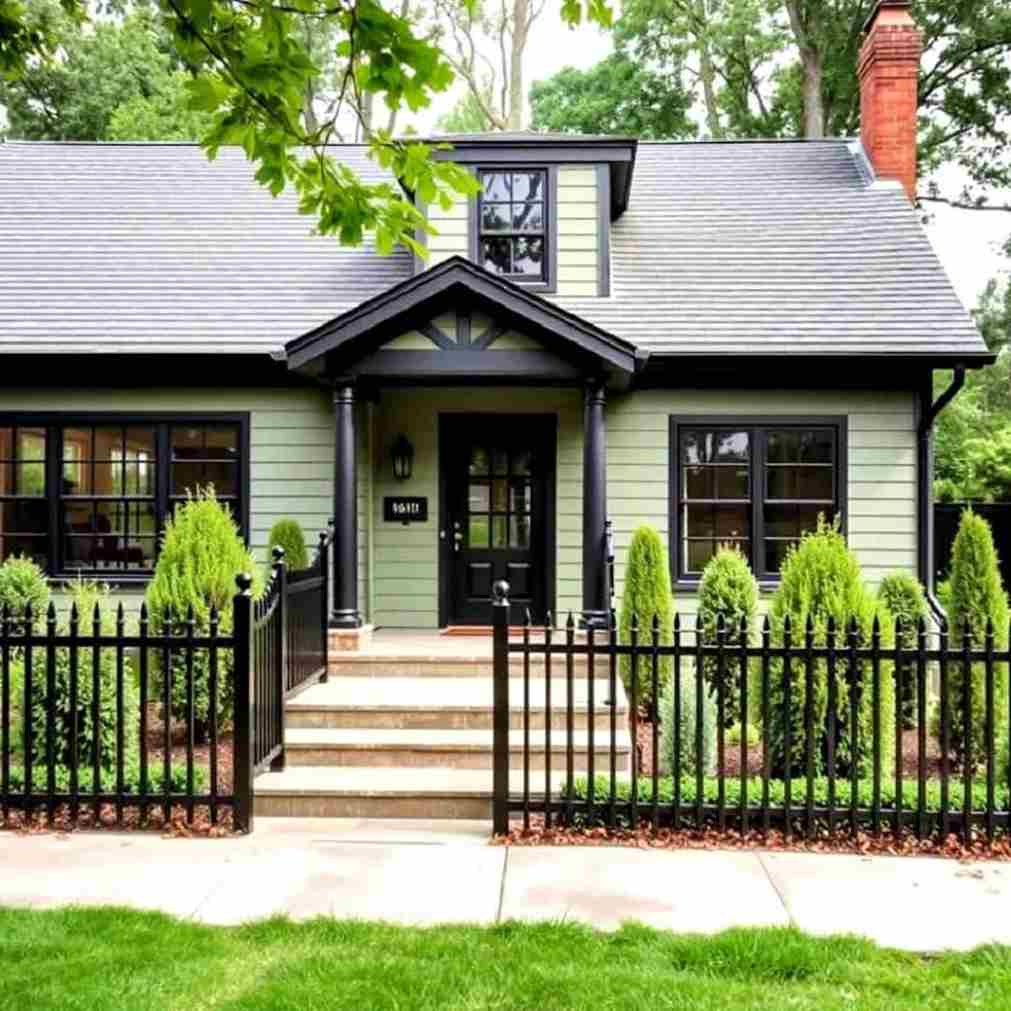
Black fencing around a sage green house creates a striking, architectural frame. The contrast is bold but not harsh, the soft sage mellows the black in the pleasing way. This combo feels current and fresh but has staying power. Whether you choose sleek modern metal fencing or classic wrought iron, that black boundary makes the sage green house pop.
The key to getting this right is choosing the right fence style for your home’s architecture. Modern homes look amazing with horizontal fences or simple vertical pickets, while traditional homes shine with ornamental iron work.
What I love about this pairing is how it defines your property with confidence. To make this combo better, add plantings that spill over or through the fence, the softness against the hard lines of the black creates beautiful contrast.
Sage green exterior with stone base
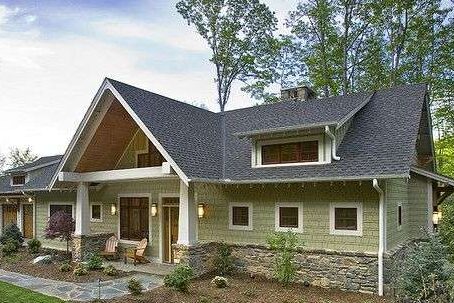
Sage green siding with a stone base creates a balance of soft color and natural texture. The stone grounds the home while the sage adds that perfect amount of color interest. This combination works on many architectural styles like craftsman, farmhouse, colonial, and transitional designs.
For the cohesive look, choose stone in colors that complement sage like grays, tans, and browns with hints of green work. Make sure there’s a transition point between stone and siding, a trim board or ledge creates a visual break.
I think this combination is smart because it solves practical problems while looking gorgeous. For a special touch, consider using the same stone on other elements like a front porch or garden walls to tie everything together.
Pair olive and sage green exterior
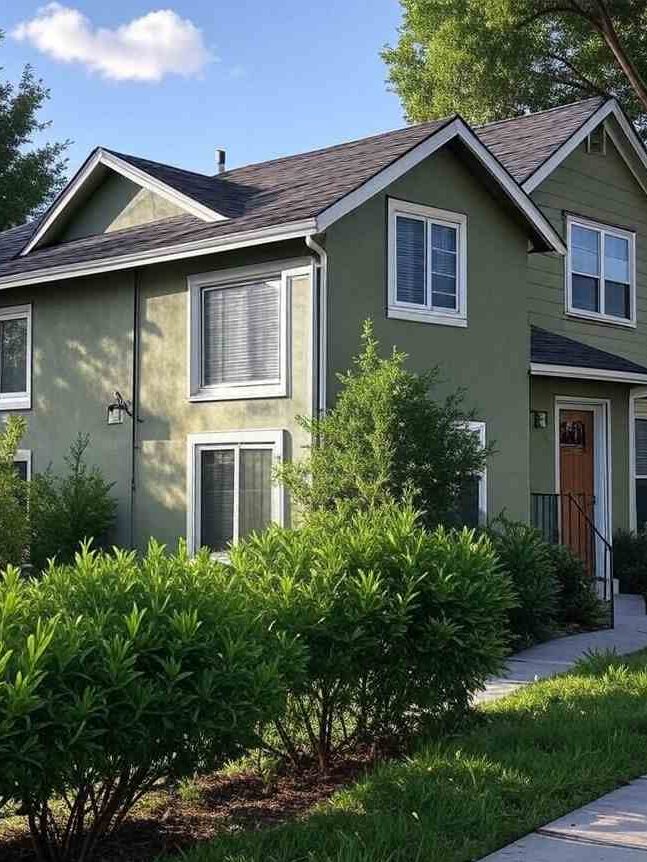
Pairing olive green with sage green on your house exterior creates a rich, layered look. It’s like creating depth without having to add different materials. The deep olive plays beautifully with the soft sage, creating visual interest that changes throughout the day.
To pull this off, use the dark olive on architectural details like on the trim, shutters, or as an accent on a gable or porch ceiling. Keep the main walls in the light sage. The contrast should be noticeable but not harsh.
What I love about this pairing is how it highlights architectural details without screaming for attention. This works well on houses with details as the color variation helps features stand out.
Sage house, black trim and white windows
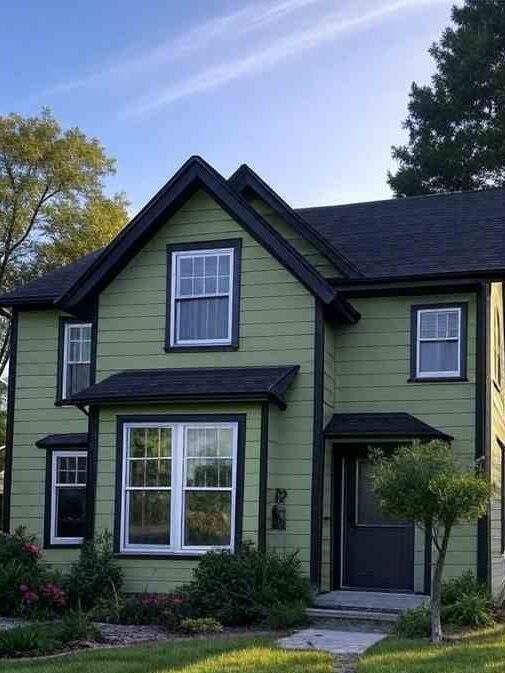
This three-color combo, sage walls, black trim, and white windows creates a balanced, interesting exterior. The sage provides a soft, natural backdrop, while the black trim adds definition and the white windows keep everything bright and fresh. This combination works on any style home, from traditional to modern.
For this look to work, choose a mid-tone sage that has depth to stand up to the black but not that dark that it competes with it. Benjamin Moore’s “Saybrook Sage” would be perfect. Use black on fascia boards, porch railings, and door frames, but keep window sashes and muntins white.
I adore how this combination balances modern and traditional vibes. The black feels current while the white keeps things classic, and the sage bridges both worlds beautifully. To make this combo shine, add natural wood elements like a front door or porch ceiling, the warmth plays beautifully against the sage and black and white.
Dark green house with black gutters
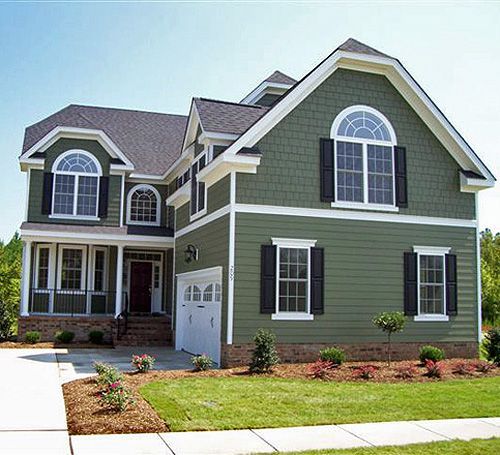
Dark sage green siding paired with black gutters and downspouts creates a sophisticated, cohesive look. The black hardware disappears against the deep green, creating sleek lines that frame the house. This combination feels intentional and high-end. It works well on modern farmhouses, craftsman homes, and contemporary designs.
What I love about this combination is how it takes something functional like gutters and turns them into a design element. Rather than trying to hide them, this approach highlights this feature. This is definitely a combination that makes your house look like it was designed.
Wooden deck with sage green house
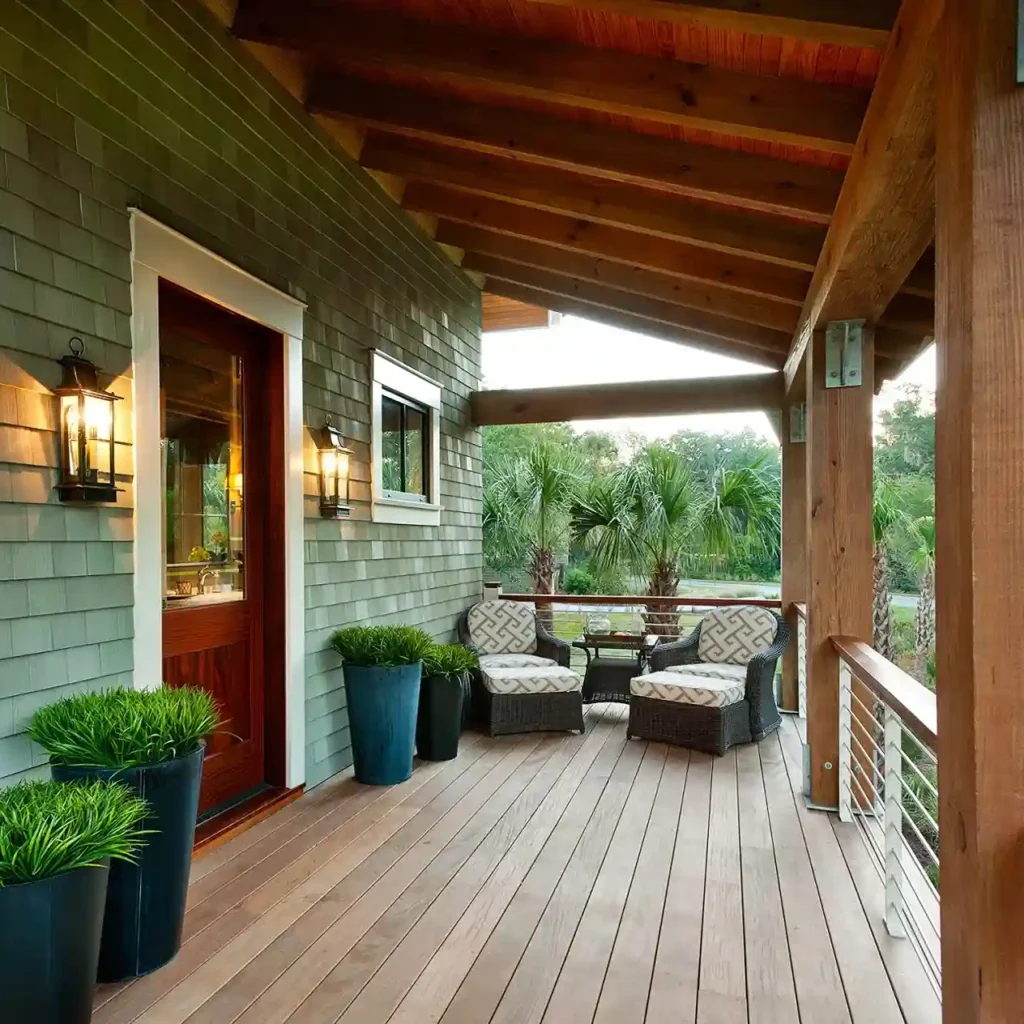
A natural wood deck against a sage green house creates an indoor-outdoor connection. The warm wood tones complement the cool sage in a beautiful way. This pairing feels organic and welcoming. Whether your home is a cabin in the woods or a suburban two-story, this combo works.
For the stunning effect, choose a wood with character and color variation like cedar, redwood, or pressure-treated lumber that has a warm honey tone. The sage should be light to create contrast with the wood.
I think what makes this combo successful is how it blurs the line between architecture and nature. The wood connects to the landscape while the sage connects to the foliage. To take this look further, add comfortable seating in colors that complement both the deck and the house. Add potted plants with flowers that pop against the sage background.
Black pergola against green house
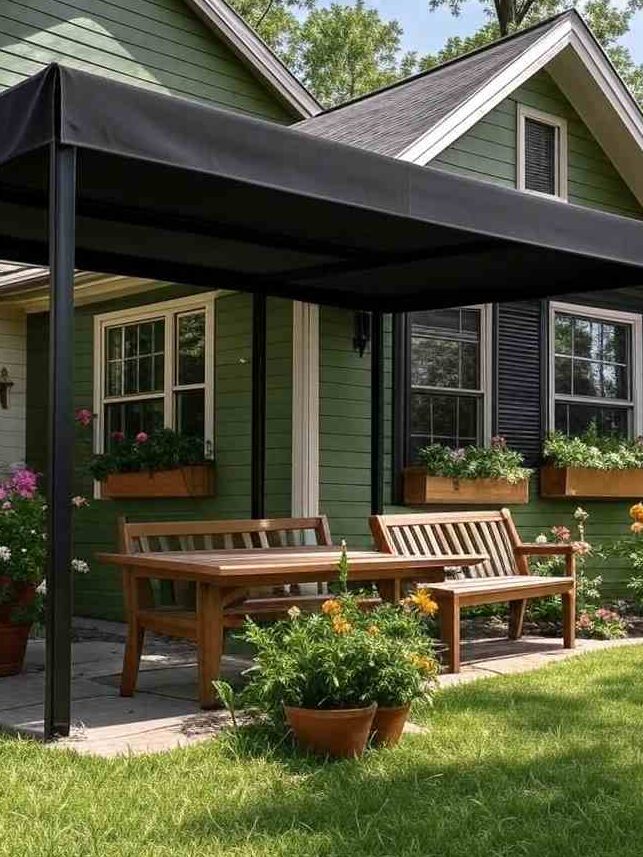
This combination creates a striking architectural feature that frames outdoor living space beautifully. The black structure stands out boldly against the soft sage, creating a focal point that draws the eye and adds visual appeal.
To nail this look, the pergola should be substantial like chunky posts and beams rather than spindly. Paint or stain it in a true black with a matte or satin finish. The sage green should have a body to stand up to the black like Sherwin-Williams’ “Acacia Haze” would be perfect.
What I love about this pairing is the way it creates an outdoor room without walls. The structure defines the space while the contrast between black and sage creates visual interest.
Go for gray and sage green facade
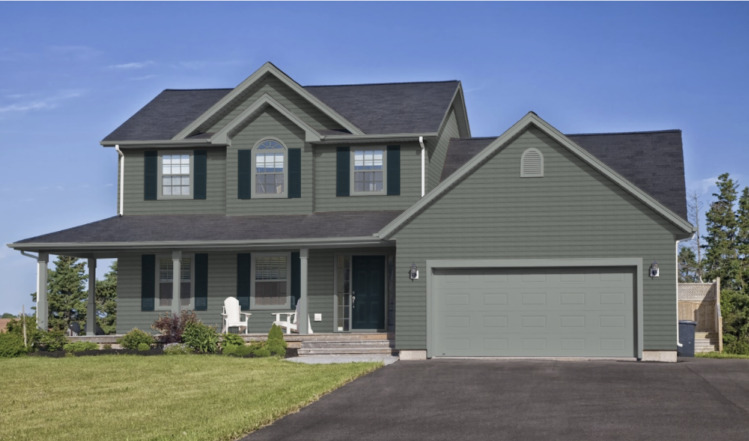
Pairing gray with sage green on your house exterior creates a sophisticated, layered look. The cool gray complements the muted sage beautifully, creating depth without contrast that’s harsh. This combination feels current but not trendy, it’s the kind of color pairing that ages well and looks intentional.
To execute this look, you’ve got options like use gray on the trim with sage walls, the colors on different architectural elements, or use sage as an accent on a gray house.
I love how this combination feels both current and timeless. To enhance this pairing, add black accents like the front door, window sashes, or light fixtures. The black provides a contrast that makes the gray and sage go together beautifully.
Black garage door with dark green house
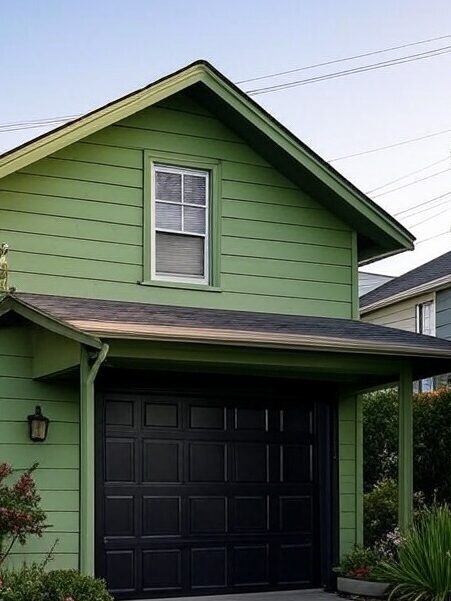
A black garage door on a dark sage green house creates a striking, cohesive look. Garages can take up visual space on a home’s exterior, turning the door into a design feature rather than an eyesore is smart. The black door feels intentional and architectural against the deep green background.
To get this look right, choose a dark sage with depth like Farrow & Ball’s “Treron.” The garage door should be a true black in a satin or low-gloss finish to reduce fingerprints and dirt. Consider a door with architectural interest like panels or windows across the top to add character.
What I find clever about this combination is how it turns an awkward feature into a design statement.
Sage green house with black windows
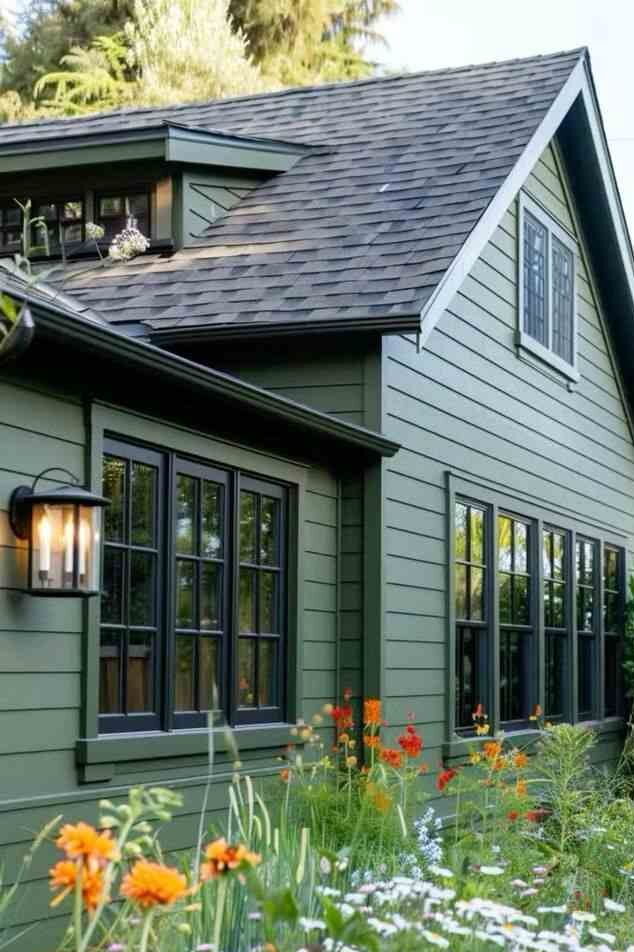
Sage green siding paired with black window frames creates a contemporary-meets-traditional vibe. The black frames define and highlight the windows beautifully. This contrast feels fresh and architectural without being trendy. It works on any style home, from modern to traditional.
For this look to shine, choose a mid-tone sage that creates contrast with the black. Benjamin Moore’s “Saybrook Sage” is perfect. Make sure all the windows get the black treatment mixing window colors does not work. Consider carrying the black to other elements like the front door, light fixtures, and hardware for a cohesive look.
I love how this combination makes windows look big and important. The contrast draws your eye right to them, which is perfect because windows are like the eyes of your house. To make this combo better, add black flower boxes under some windows because they’ll pop against the sage and add charm.
Incorporate landscaping against green house
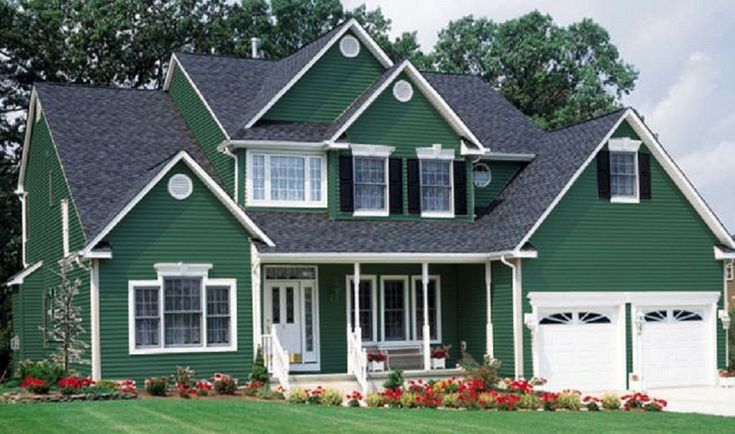
Landscaping against a sage green house is pure magic. When the plants and hardscaping complement that soft green backdrop, everything goes together. The sage becomes this perfect neutral canvas that makes plants pop while connecting with them.
To nail this look, mix plants with different heights, textures, and different green tones. Add plants with silver foliage to create beautiful contrast. For flowering plants, purples, blues, whites, and pinks look amazing against sage but bright reds or oranges can compete.
What I love about this approach is how it blurs the line between architecture and nature. Add natural stone elements in your hardscaping like a stone path or wall picks up the gray undertones in sage beautifully.
Sage green house with brown trim
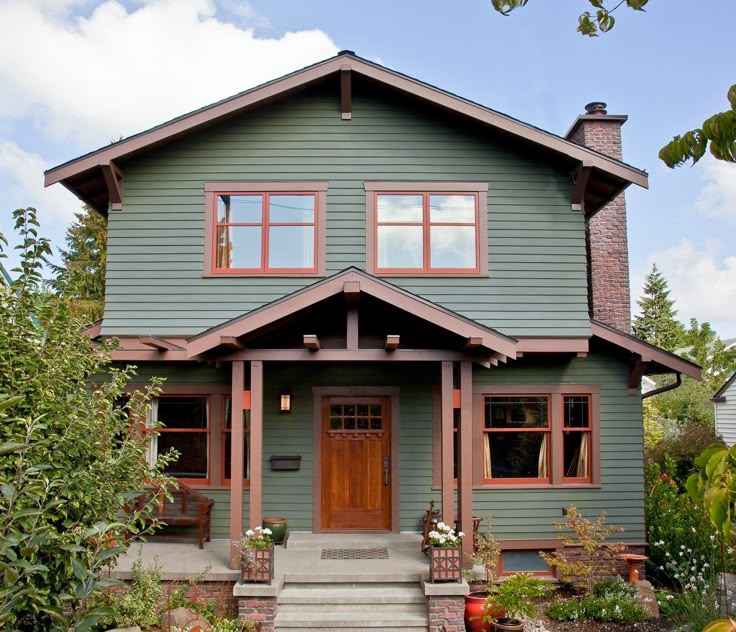
Sage green siding with brown trim creates a rich, earthy combination. The warmth of the brown balances the coolness of sage perfectly, creating depth and interest without contrast. It works beautifully on craftsman styles, cabins, cottages, and ranch homes.
For this look to work, choose a medium to dark brown with warm undertones like walnut or chestnut rather than chocolate or espresso. Use it on all trim, fascia boards, and the front door too. The sage should be light to create contrast like Sherwin-Williams’ “Sage Green Light” is beautiful.
I think what makes this combination appealing is how natural and unforced it feels. To enhance this look further, add natural stone elements in your landscaping or on the house like a stone chimney or foundation. The multiple natural elements create a harmonious, welcoming exterior that feels established and thoughtful.
Black-framed mailbox with sage exterior
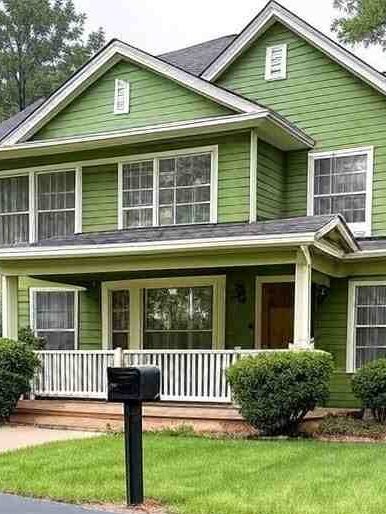
A black-framed mailbox against a sage green house is like a small detail, but it makes an impact. That black against the soft sage creates beautiful contrast and adds a touch of modernity to home style.
What I love about this simple upgrade is how much contrast you get from it. A new mailbox is an inexpensive update that makes your exterior look intentional. To take this idea up, add plantings around a post-mounted mailbox like ornamental grasses or low-growing perennials. The plants will soften the hardness of the black while connecting to your sage green house.
One-story sage green farmhouse
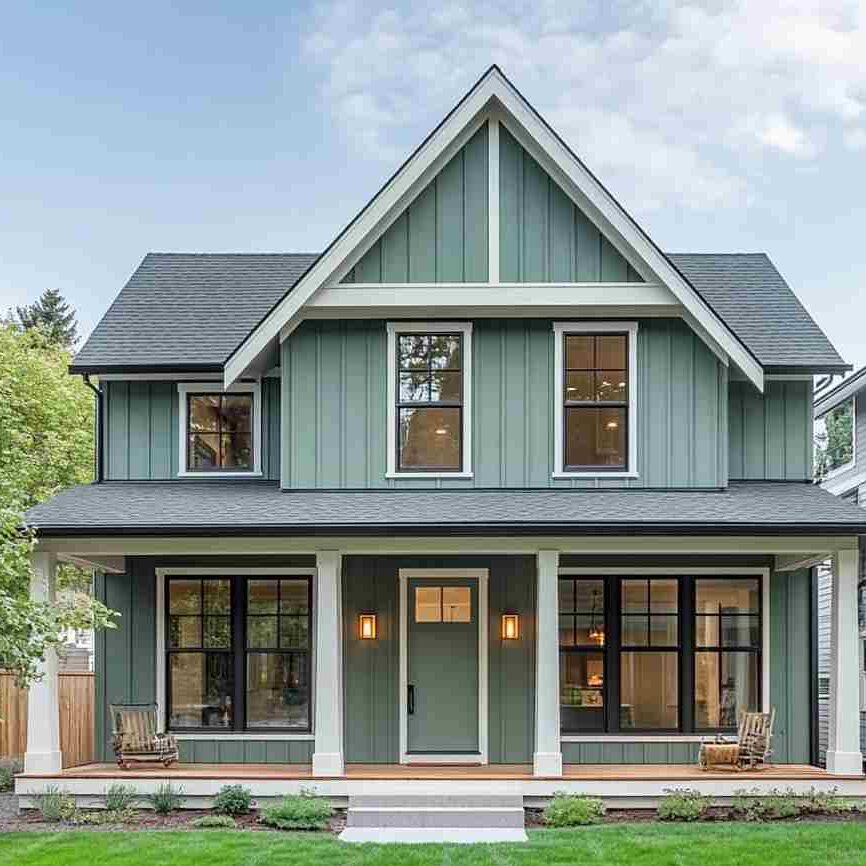
One-story sage green farmhouses have a cozy-yet-modern vibe. The horizontal lines of a single-story home let that sage color shine without being overwhelming. This combo feels welcoming, approachable, and right, not too big, not too small, not too bold, not too boring.
To get this farmhouse look right, choose a true sage with gray undertones rather than a yellowish green. Behr’s “Nature’s Gift” is perfect. Pair it with white trim to highlight architectural details like window frames, corner boards, and eaves. Consider black accents for contrast like black shutters, lighting fixtures, or a black front door.
I love how one-story homes in sage green feel connected to their surroundings. They sit on the land rather than going over it, creating a harmony with nature. To enhance this connection, add a front porch with simple columns and a natural wood ceiling.
What colors do not go with sage green?
While sage green plays nice with almost every color, there are a few ones that don’t work.
Bright, primary colors like fire-engine red, royal blue, or bright yellow can look harsh against sage’s muted nature. The soft, gray-green tones of sage get overwhelmed by the intense colors.
Baby blues, pale pinks, and lavenders can make sage look muddy and bright oranges sit opposite green on the color wheel, creating contrast that’s harsh for sage’s subtle personality.
Stick with neutrals like white, cream, black, grays, browns and other nature-inspired colors as your companions to sage green. If you want color beyond that, go for muted ones rather than bright ones like burgundy instead of bright red, navy instead of royal blue.
Conclusion
Sage green house offers a balance of personality and versatility. This color manages to be interesting without being polarizing, timeless without being boring. Whether you’re pairing it with white trim for a classic look or black accents for modern edge, sage green provides the perfect backdrop.
What I love about sage green exteriors is how they connect architecture to nature. The soft, muted green feels at home in any setting like wooded lots, beachy neighborhoods, or suburban streets. It changes beautifully throughout the day, sometimes leaning gray, sometimes green.
It’s one of those rare colors that looks good for a long period of time. Start with something small if you’re in doubt but if you are sure then go big. Whether you’re going for farmhouse charm or modern sophistication, sage green creates a serene, welcoming exterior.
I hope these 23 sage green house ideas has inspired you in some way and you got what you were searching for because it has a nature-inspired, versatile quality which is important for a house exterior.

